2013 JEEP GRAND CHEROKEE window
[x] Cancel search: windowPage 74 of 408
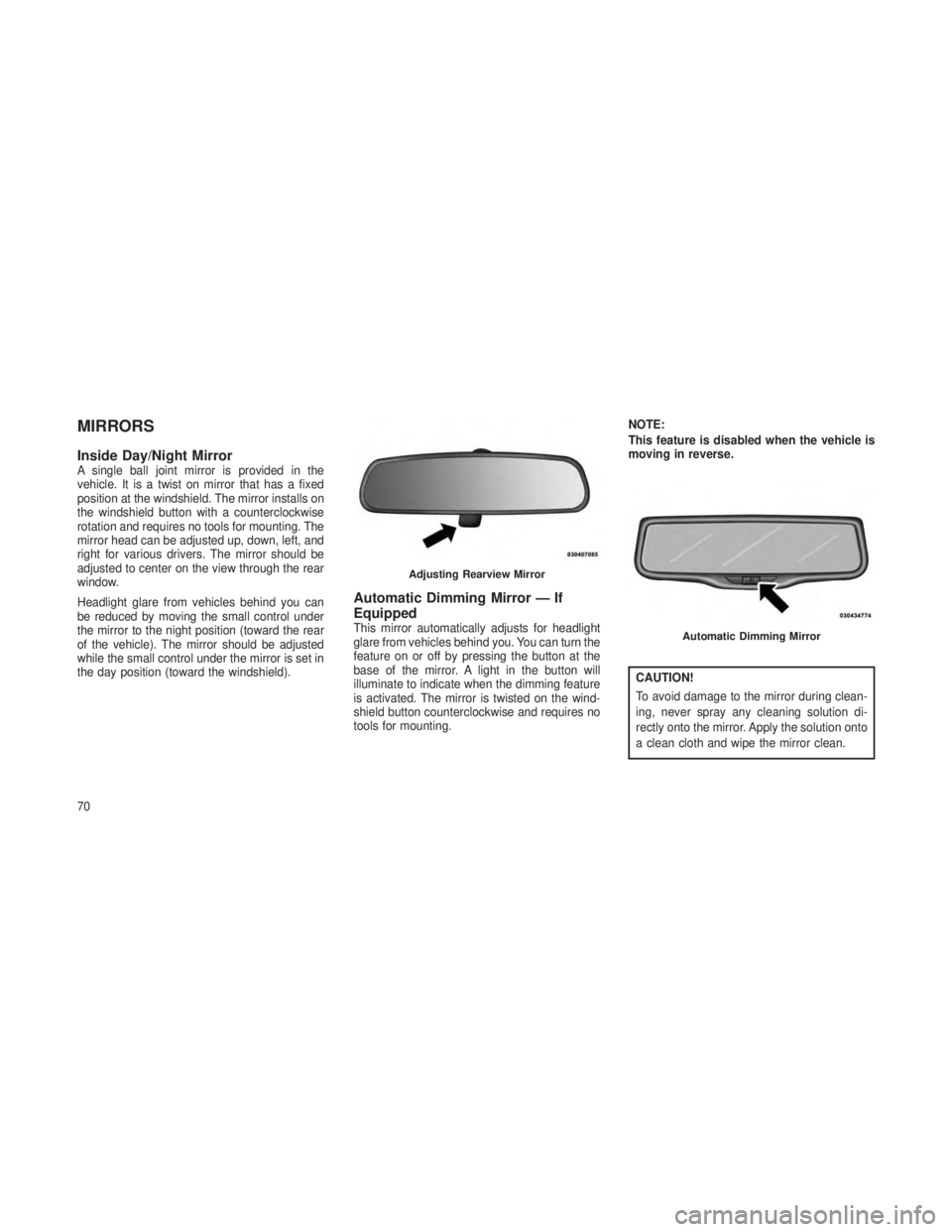
MIRRORS
Inside Day/Night MirrorA single ball joint mirror is provided in the
vehicle. It is a twist on mirror that has a fixed
position at the windshield. The mirror installs on
the windshield button with a counterclockwise
rotation and requires no tools for mounting. The
mirror head can be adjusted up, down, left, and
right for various drivers. The mirror should be
adjusted to center on the view through the rear
window.
Headlight glare from vehicles behind you can
be reduced by moving the small control under
the mirror to the night position (toward the rear
of the vehicle). The mirror should be adjusted
while the small control under the mirror is set in
the day position (toward the windshield).
Automatic Dimming Mirror — If
Equipped
This mirror automatically adjusts for headlight
glare from vehicles behind you. You can turn the
feature on or off by pressing the button at the
base of the mirror. A light in the button will
illuminate to indicate when the dimming feature
is activated. The mirror is twisted on the wind-
shield button counterclockwise and requires no
tools for mounting.NOTE:
This feature is disabled when the vehicle is
moving in reverse.
CAUTION!
To avoid damage to the mirror during clean-
ing, never spray any cleaning solution di-
rectly onto the mirror. Apply the solution onto
a clean cloth and wipe the mirror clean.
Adjusting Rearview Mirror
Automatic Dimming Mirror
70
Page 76 of 408
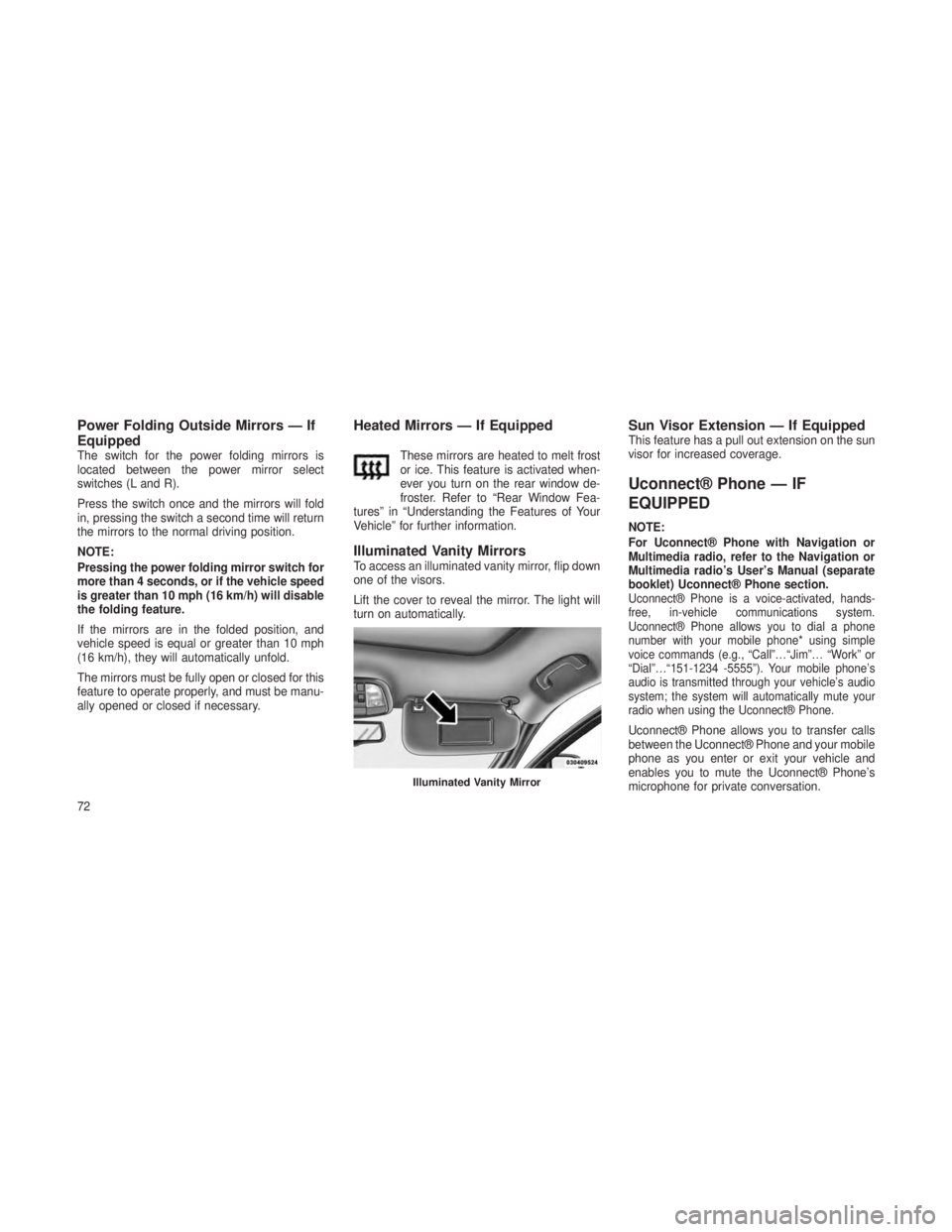
Power Folding Outside Mirrors — If
Equipped
The switch for the power folding mirrors is
located between the power mirror select
switches (L and R).
Press the switch once and the mirrors will fold
in, pressing the switch a second time will return
the mirrors to the normal driving position.
NOTE:
Pressing the power folding mirror switch for
more than 4 seconds, or if the vehicle speed
is greater than 10 mph (16 km/h) will disable
the folding feature.
If the mirrors are in the folded position, and
vehicle speed is equal or greater than 10 mph
(16 km/h), they will automatically unfold.
The mirrors must be fully open or closed for this
feature to operate properly, and must be manu-
ally opened or closed if necessary.
Heated Mirrors — If Equipped
These mirrors are heated to melt frost
or ice. This feature is activated when-
ever you turn on the rear window de-
froster. Refer to “Rear Window Fea-
tures” in “Understanding the Features of Your
Vehicle” for further information.
Illuminated Vanity MirrorsTo access an illuminated vanity mirror, flip down
one of the visors.
Lift the cover to reveal the mirror. The light will
turn on automatically.
Sun Visor Extension — If EquippedThis feature has a pull out extension on the sun
visor for increased coverage.
Uconnect® Phone — IF
EQUIPPED
NOTE:
For Uconnect® Phone with Navigation or
Multimedia radio, refer to the Navigation or
Multimedia radio’s User’s Manual (separate
booklet) Uconnect® Phone section.
Uconnect® Phone is a voice-activated, hands-
free, in-vehicle communications system.
Uconnect® Phone allows you to dial a phone
number with your mobile phone* using simple
voice commands (e.g., “Call”…“Jim”… “Work” or
“Dial”…“151-1234 -5555”). Your mobile phone’s
audio is transmitted through your vehicle’s audio
system; the system will automatically mute your
radio when using the Uconnect® Phone.
Uconnect® Phone allows you to transfer calls
between the Uconnect® Phone and your mobile
phone as you enter or exit your vehicle and
enables you to mute the Uconnect® Phone’s
microphone for private conversation.
Illuminated Vanity Mirror
72
Page 87 of 408
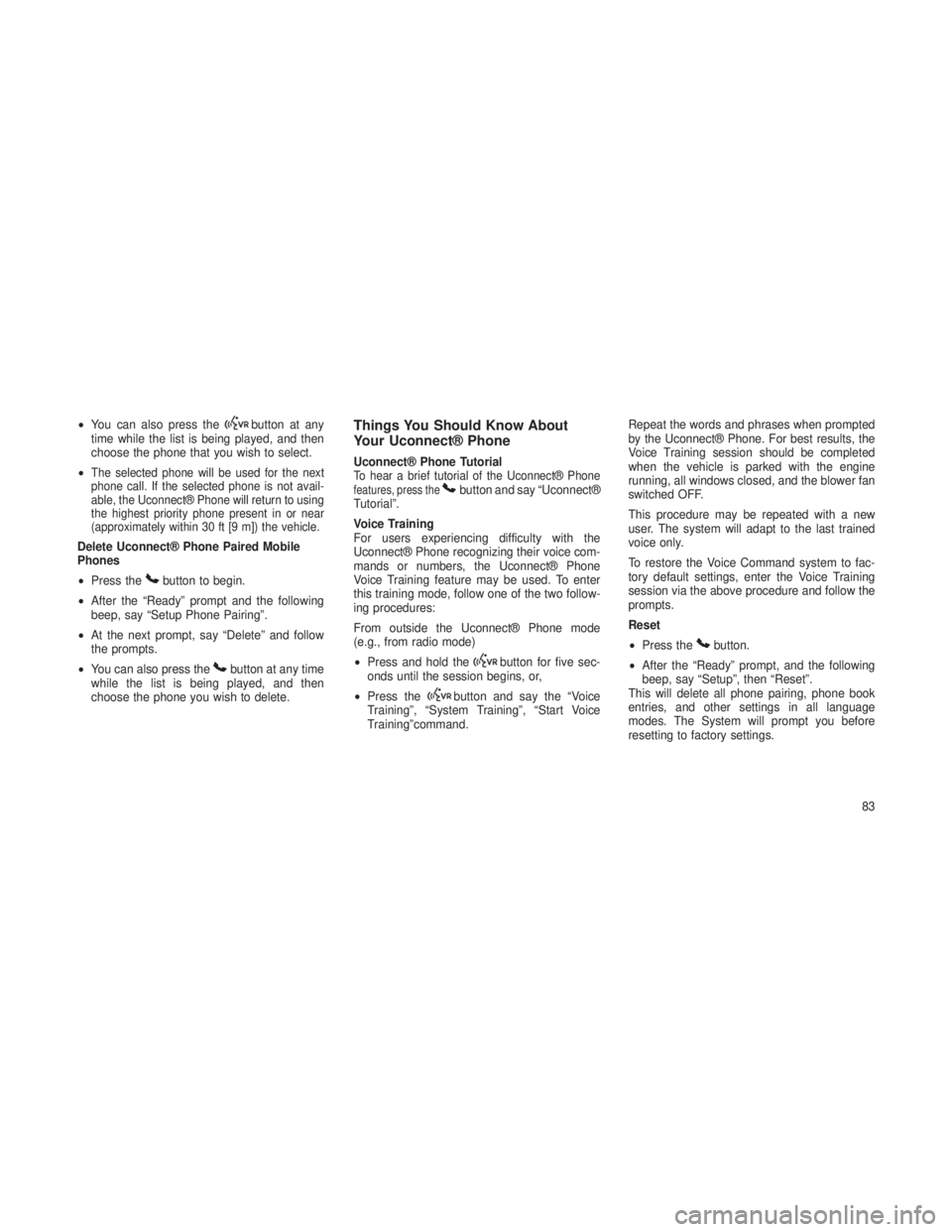
•You can also press thebutton at any
time while the list is being played, and then
choose the phone that you wish to select.
•
The selected phone will be used for the next
phone call. If the selected phone is not avail-
able, the Uconnect® Phone will return to using
the highest priority phone present in or near
(approximately within 30 ft [9 m]) the vehicle.
Delete Uconnect® Phone Paired Mobile
Phones
• Press the
button to begin.
• After the “Ready” prompt and the following
beep, say “Setup Phone Pairing”.
• At the next prompt, say “Delete” and follow
the prompts.
• You can also press the
button at any time
while the list is being played, and then
choose the phone you wish to delete.
Things You Should Know About
Your Uconnect® Phone
Uconnect® Phone TutorialTo hear a brief tutorial of the Uconnect® Phonefeatures, press thebutton and say “Uconnect®
Tutorial”.
Voice Training
For users experiencing difficulty with the
Uconnect® Phone recognizing their voice com-
mands or numbers, the Uconnect® Phone
Voice Training feature may be used. To enter
this training mode, follow one of the two follow-
ing procedures:
From outside the Uconnect® Phone mode
(e.g., from radio mode)
• Press and hold the
button for five sec-
onds until the session begins, or,
• Press the
button and say the “Voice
Training”, “System Training”, “Start Voice
Training”command. Repeat the words and phrases when prompted
by the Uconnect® Phone. For best results, the
Voice Training session should be completed
when the vehicle is parked with the engine
running, all windows closed, and the blower fan
switched OFF.
This procedure may be repeated with a new
user. The system will adapt to the last trained
voice only.
To restore the Voice Command system to fac-
tory default settings, enter the Voice Training
session via the above procedure and follow the
prompts.
Reset
•
Press the
button.
• After the “Ready” prompt, and the following
beep, say “Setup”, then “Reset”.
This will delete all phone pairing, phone book
entries, and other settings in all language
modes. The System will prompt you before
resetting to factory settings.
83
Page 88 of 408
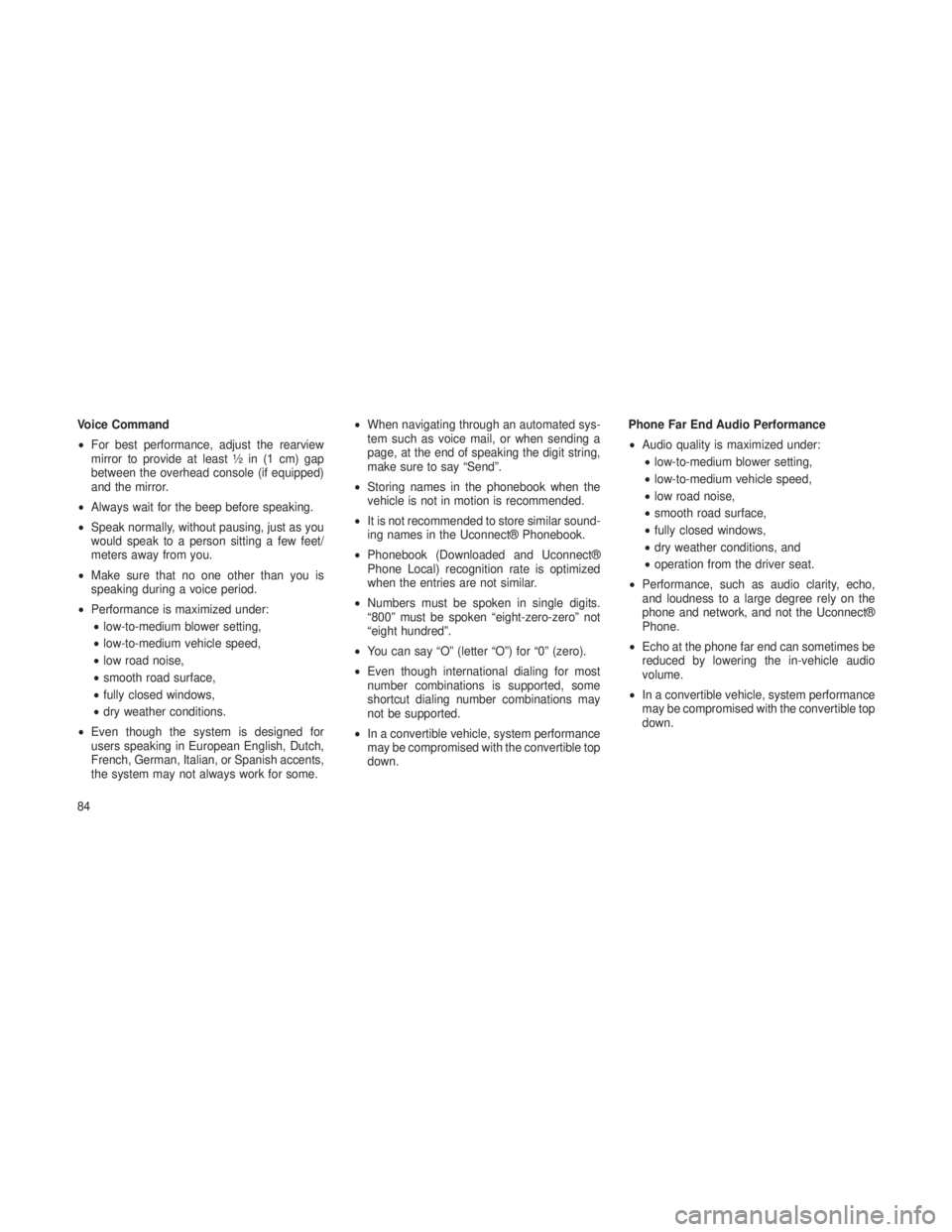
Voice Command
•For best performance, adjust the rearview
mirror to provide at least ½ in (1 cm) gap
between the overhead console (if equipped)
and the mirror.
• Always wait for the beep before speaking.
• Speak normally, without pausing, just as you
would speak to a person sitting a few feet/
meters away from you.
• Make sure that no one other than you is
speaking during a voice period.
• Performance is maximized under:
• low-to-medium blower setting,
• low-to-medium vehicle speed,
• low road noise,
• smooth road surface,
• fully closed windows,
• dry weather conditions.
• Even though the system is designed for
users speaking in European English, Dutch,
French, German, Italian, or Spanish accents,
the system may not always work for some. •
When navigating through an automated sys-
tem such as voice mail, or when sending a
page, at the end of speaking the digit string,
make sure to say “Send”.
• Storing names in the phonebook when the
vehicle is not in motion is recommended.
• It is not recommended to store similar sound-
ing names in the Uconnect® Phonebook.
• Phonebook (Downloaded and Uconnect®
Phone Local) recognition rate is optimized
when the entries are not similar.
• Numbers must be spoken in single digits.
“800” must be spoken “eight-zero-zero” not
“eight hundred”.
• You can say “O” (letter “O”) for “0” (zero).
• Even though international dialing for most
number combinations is supported, some
shortcut dialing number combinations may
not be supported.
• In a convertible vehicle, system performance
may be compromised with the convertible top
down. Phone Far End Audio Performance
•
Audio quality is maximized under:
• low-to-medium blower setting,
• low-to-medium vehicle speed,
• low road noise,
• smooth road surface,
• fully closed windows,
• dry weather conditions, and
• operation from the driver seat.
• Performance, such as audio clarity, echo,
and loudness to a large degree rely on the
phone and network, and not the Uconnect®
Phone.
• Echo at the phone far end can sometimes be
reduced by lowering the in-vehicle audio
volume.
• In a convertible vehicle, system performance
may be compromised with the convertible top
down.
84
Page 95 of 408
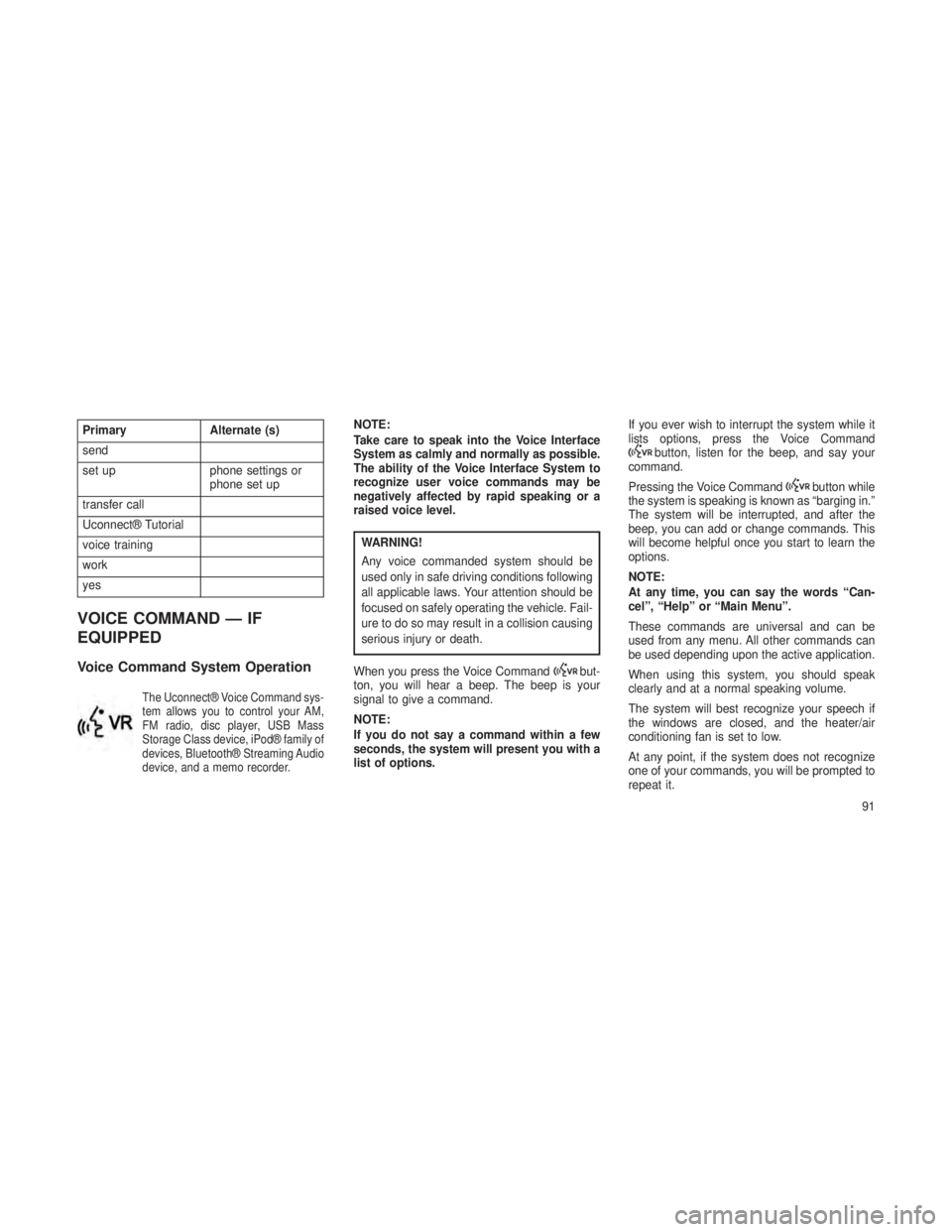
PrimaryAlternate (s)
send
set up phone settings or
phone set up
transfer call
Uconnect® Tutorial
voice training
work
yes
VOICE COMMAND — IF
EQUIPPED
Voice Command System Operation
The Uconnect® Voice Command sys-
tem allows you to control your AM,
FM radio, disc player, USB Mass
Storage Class device, iPod® family of
devices, Bluetooth® Streaming Audio
device, and a memo recorder.
NOTE:
Take care to speak into the Voice Interface
System as calmly and normally as possible.
The ability of the Voice Interface System to
recognize user voice commands may be
negatively affected by rapid speaking or a
raised voice level.
WARNING!
Any voice commanded system should be
used only in safe driving conditions following
all applicable laws. Your attention should be
focused on safely operating the vehicle. Fail-
ure to do so may result in a collision causing
serious injury or death.
When you press the Voice Command
but-
ton, you will hear a beep. The beep is your
signal to give a command.
NOTE:
If you do not say a command within a few
seconds, the system will present you with a
list of options. If you ever wish to interrupt the system while it
lists options, press the Voice Command
button, listen for the beep, and say your
command.
Pressing the Voice Command
button while
the system is speaking is known as “barging in.”
The system will be interrupted, and after the
beep, you can add or change commands. This
will become helpful once you start to learn the
options.
NOTE:
At any time, you can say the words “Can-
cel”, “Help” or “Main Menu”.
These commands are universal and can be
used from any menu. All other commands can
be used depending upon the active application.
When using this system, you should speak
clearly and at a normal speaking volume.
The system will best recognize your speech if
the windows are closed, and the heater/air
conditioning fan is set to low.
At any point, if the system does not recognize
one of your commands, you will be prompted to
repeat it.
91
Page 98 of 408

NOTE:
Keep in mind that you have to press the
Voice Command
button first and wait
for the beep before speaking the “Barge In”
commands.
Voice TrainingFor users experiencing difficulty with the system
recognizing their voice commands or numbers
the Uconnect® Voice “Voice Training” feature
may be used.
1. Press the Voice Command
button, say
“System Setup” and once you are in that menu
then say “Voice Training.” This will train your
own voice to the system and will improve rec-
ognition.
2. Repeat the words and phrases when
prompted by Uconnect® Voice. For best results,
the Voice Training session should be completed
when the vehicle is parked, engine running, all
windows closed, and the blower fan switched
off. This procedure may be repeated with a new
user. The system will adapt to the last trained
voice only.
SEATS
Seats are part of the Occupant Restraint Sys-
tem of the vehicle.
WARNING!
• It is dangerous to ride in a cargo area,
inside or outside of a vehicle. In a collision,
people riding in these areas are more likely
to be seriously injured or killed.
• Do not allow people to ride in any area of
your vehicle that is not equipped with seats
and seat belts. In a collision, people riding
in these areas are more likely to be seri-
ously injured or killed.
• Be sure everyone in your vehicle is in a
seat and using a seat belt properly.
Power Seats — If EquippedSome models may be equipped with eight-way
power driver and front passenger seats. The
power seat switches are located on the out-
board side of the seat. There are two switches
that control the movement of the seat cushion
and the seatback. Adjusting The Seat Forward Or Rearward
The seat can be adjusted both forward and
rearward. Push the seat switch forward or rear-
ward, the seat will move in the direction of the
switch. Release the switch when the desired
position has been reached.
Power Seat Switches
1 — Seatback Switch
2 — Seat Switch
94
Page 116 of 408

Multifunction LeverThe multifunction lever is located on the left side
of the steering column.
Turn SignalsMove the multifunction lever up or down and the
arrows on each side of the instrument cluster
flash to show proper operation of the front and
rear turn signal lights.NOTE:
If either light remains on and does not flash,
or there is a very fast flash rate, check for a
defective outside light bulb. If an indicator
fails to light when the lever is moved, it
would suggest that the indicator bulb is
defective.
Lane Change AssistTap the lever up or down once, without moving
beyond the detent, and the turn signal (right or left)
will flash three times then automatically turn off.
Flash-To-PassYou can signal another vehicle with your head-
lights by partially pulling the multifunction lever
toward the steering wheel. This will cause the
high beam headlights to turn on until the lever is
released.
High/Low Beam SwitchPush the multifunction lever toward the instru-
ment panel to switch the headlights to high
beam. Pulling the multifunction back toward the
steering wheel will turn the low beams back on,
or shut the high beams off.
WINDSHIELD WIPERS AND
WASHERS
The windshield wiper/washer controls are lo-
cated on the multifunction lever on the left side
of the steering column. The front wipers are
operated by rotating a switch, located on the
end of the lever. For information on the rear
wiper/washer, refer to “Rear Window Features”
in “Understanding The Features Of Your Ve-
hicle”.
Multifunction Lever
Multifunction Lever
11 2
Page 147 of 408

Closing Sunroof — Manual ModeTo close the sunroof, press and hold the switch
in the forward position. Any release of the
switch will stop the movement and the sunroof
will remain in a partially closed condition until
the switch is pushed and held forward again.
Pinch Protect FeatureThis feature will detect an obstruction in the
opening of the sunroof during Express Close
operation. If an obstruction in the path of the
sunroof is detected, the sunroof will automati-
cally retract. Remove the obstruction if this
occurs. Next, press the switch forward and
release to Express Close.
NOTE:
If three consecutive sunroof close attempts
result in Pinch Protect reversals, the fourth
close attempt will be a Manual Close move-
ment with Pinch Protect disabled.
Venting Sunroof — ExpressPress and release the Vent button within one
half second and the sunroof will open to the
vent position. This is called “Express Vent”, and
it will occur regardless of sunroof position. Dur-
ing Express Vent operation, any movement of
the switch will stop the sunroof.
Sunshade OperationThe sunshade can be opened manually. How-
ever, the sunshade will open automatically as
the sunroof opens.
NOTE:
The sunshade cannot be closed if the sun-
roof is open.
Wind BuffetingWind buffeting can be described as the percep-
tion of pressure on the ears or a helicopter-type
sound in the ears. Your vehicle may exhibit wind
buffeting with the windows down, or the sunroof
(if equipped) in certain open or partially openpositions. This is a normal occurrence and can
be minimized. If the buffeting occurs with the
rear windows open, open the front and rear
windows together to minimize the buffeting. If
the buffeting occurs with the sunroof open,
adjust the sunroof opening to minimize the
buffeting or open any window.
Sunroof MaintenanceUse only a nonabrasive cleaner and a soft cloth
to clean the glass panel.
Ignition OFF OperationThe power sunroof switches remain active for
up to approximately ten minutes after the igni-
tion switch has been turned OFF. Opening
either front door will cancel this feature. The
time is programmable. Refer to “Electronic Ve-
hicle Information Center (EVIC)/Personal Set-
tings (Customer-Programmable Features)” in
“Understanding Your Instrument Panel” for fur-
ther information.
143